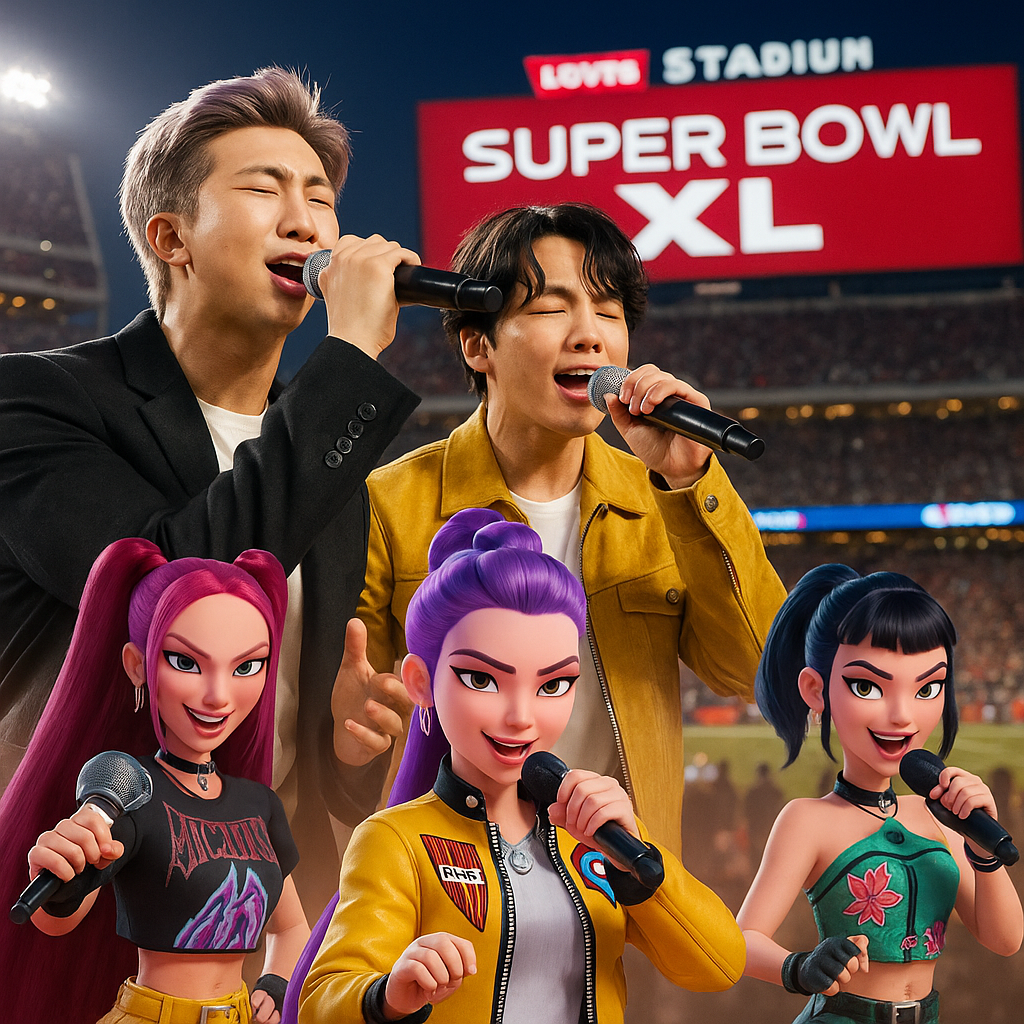Part 1. Could K-Pop Groups Take Over the Super Bowl Halftime Show?
The roar of a stadium filled with over 70,000 fans. The flashing cameras. The anticipation that builds with every beat of the drum as the world’s biggest live television audience—over 100 million viewers worldwide—holds its breath for the spectacle that is the Super Bowl Halftime Show.
Now, imagine that iconic moment not filled with the familiar sight of Beyoncé, The Weeknd, or Rihanna, but with the explosive choreography and electrifying beats of K-Pop. Imagine BTS, or even the fictional yet globally beloved groups from Netflix’s “KPop Demon Hunters”, commanding the stage. The thought alone has electrified conversations across fan forums, entertainment columns, and sports culture debates. Could 2026 finally be the year when K-Pop storms the Super Bowl?
---
The Setting: Super Bowl LX in California
On February 8, 2026, the Super Bowl returns to California, with Levi’s Stadium in Santa Clara serving as the grand stage. This is not just any sports match—it is the cultural event of the year in the United States. More than the game itself, millions of viewers tune in for the halftime performance, a tradition that has elevated pop stars into living legends.
For years, the halftime stage has been a showcase of American pop culture dominance. Michael Jackson in 1993. U2 in 2002. Shakira and Jennifer Lopez in 2020. Rihanna’s pregnancy reveal in 2023. The Halftime Show is both a personal milestone for artists and a historical marker in music history.
But the globalization of pop culture has opened new possibilities. The NFL and its sponsors are increasingly aware that the Super Bowl is not just watched in the U.S.—it is consumed across continents. Latin music, hip-hop, EDM, and Afrobeat have made their way into mainstream halftime discussions. So why not K-Pop, the biggest global cultural export of the past decade?
---
BTS: A Perfect Timing for a Historic Return
In Billboard’s speculative report on potential 2026 headliners, one name stood out: BTS. The seven-member group—Jin, Suga, J-Hope, RM, Jimin, V, and Jungkook—has spent the last three years largely inactive as each member fulfilled mandatory South Korean military service. By late 2025, all members will have reunited, making 2026 the perfect timing for a triumphant comeback.
The speculation makes sense. BTS are not just K-Pop idols—they are global icons who have topped the Billboard Hot 100, performed at the Grammys, spoken at the UN General Assembly, and cultivated one of the most dedicated fan bases in history, the ARMY. Their cultural footprint is unparalleled.
The symbolism of BTS standing on the Super Bowl stage, after years of silence, would be profound. It would not just be a performance but a global cultural milestone, where East meets West on the grandest platform possible.
For many fans, this feels like destiny. “They’ve already conquered every stage in the world,” one fan wrote on Twitter. “The Super Bowl is the last crown jewel.”
---
The Rise of “KPop Demon Hunters” and Virtual Idols
But BTS are not the only contenders sparking imagination. In a twist that shows just how far K-Pop has traveled, fans have also rallied behind a more unconventional idea: bringing the fictional K-Pop groups from Netflix’s animated hit ‘KPop Demon Hunters’ (KPDH) to the Super Bowl stage.
The film, released in 2025, became a global phenomenon, blending dazzling animation with the emotional power of K-Pop. Its fictional girl group, HUNTR/X (members Rumi, Mira, Zoey), and their rival boy band, Saja Boys, have become cultural icons in their own right.
The soundtrack shattered records:
- “Golden” hit #1 on the Billboard Hot 100 and the UK Official Singles Chart, a feat unheard of for an animated soundtrack.
- The OST has been streamed over 3 billion times globally.
- Tracks like “How It’s Done” and “Your Idol” dominate playlists from Seoul to São Paulo.
The voice and songwriting contributions of EJAE (Kim Eun-jae), who embodied HUNTR/X leader Rumi’s vocals, added authenticity and soul. Listeners described the songs as “empowering” and “life-changing,” with many saying the lyrics gave them strength during difficult times.
Now, fans are pushing a daring vision: what if HUNTR/X and Saja Boys—though fictional—took the Super Bowl stage through augmented reality or hologram performances, accompanied by live dancers and musicians?
Imagine 70,000 fans in Levi’s Stadium singing “Golden” in unison, their voices echoing across America’s most sacred sporting event. It’s no wonder that fan forums are buzzing with hashtags like #KPopAtTheSuperBowl and #HuntrXForHalftime.
---
Why K-Pop Fits the Super Bowl Stage
K-Pop is uniquely designed for a spectacle like the Super Bowl. Here’s why:
- Performance Precision
- Visual Grandeur
- Global Audience Appeal
- Cultural Moment
K-Pop groups are trained for years in vocal control, stage presence, and dance synchronization. The Super Bowl demands precision on a massive scale—and K-Pop artists thrive in exactly that environment.
K-Pop is not just about music; it’s about fashion, staging, lighting, and storytelling. From BTS’s pyrotechnics at Wembley to BLACKPINK’s headline set at Coachella, K-Pop has already proven its mastery of global festival stages.
The Super Bowl’s audience is international. With K-Pop being the most streamed genre on platforms like YouTube and Spotify in markets outside the U.S., inviting a K-Pop act could expand the NFL’s reach dramatically.
The inclusion of a K-Pop group would not just be entertainment—it would symbolize the shifting epicenter of global pop culture.
To be continued in Part 2…
